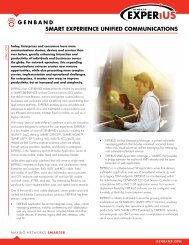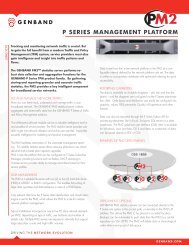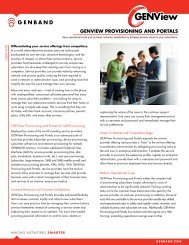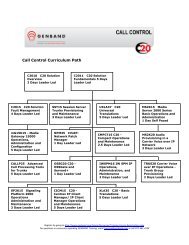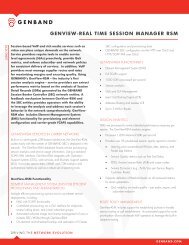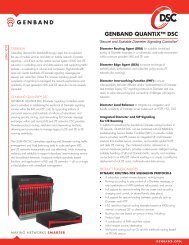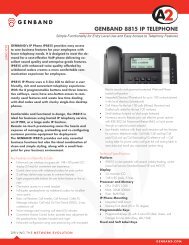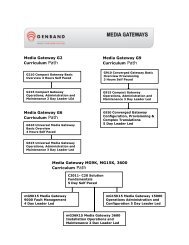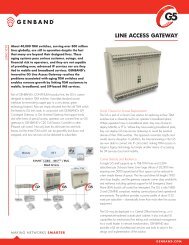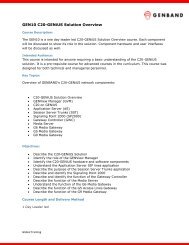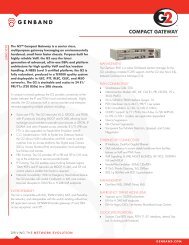Research Magic Quadrant for Softswitch Architecture - Genband
Research Magic Quadrant for Softswitch Architecture - Genband
Research Magic Quadrant for Softswitch Architecture - Genband
You also want an ePaper? Increase the reach of your titles
YUMPU automatically turns print PDFs into web optimized ePapers that Google loves.
call or send a text message — features not currently part of RCS. Future releases of RCS are<br />
likely to include functions that let customers initiate more types of communication session from<br />
the address book (chat, instant messaging, e-mail and text or voice, as well as file and video<br />
sharing), see the "presence" state and status updates of contacts, view any content their contacts<br />
choose to expose, and see aggregate in<strong>for</strong>mation within their address book about what contacts<br />
have been doing across multiple social networks.<br />
The GSMA's RCS Initiative aims to produce specifications <strong>for</strong> use by vendors, handset<br />
manufacturers and network operators. These specifications will cover the core features and<br />
implementation guidelines <strong>for</strong> interoperability across operators in any given geography, <strong>for</strong><br />
features such as presence and video calling, regardless of the client device or network<br />
architecture used.<br />
RCS services use IMS to handle underlying network features, such as authentication and<br />
charging <strong>for</strong> services. RCS defines the key interoperability requirements between IMS features,<br />
including presence, location-based services, and personalized connections between network and<br />
users. IMS has been hyped <strong>for</strong> the past five years but has only recently been found useful, thanks<br />
to RCS. IMS will serve as a complementary architecture <strong>for</strong> LTE networks.<br />
To date, over 100 CSPs, vendors, handset manufacturers and software developers have<br />
participated in the RCS Initiative. They have been developing applications and services that are<br />
extensions of SMS — <strong>for</strong> example, mobile video sharing — as well as deep packet inspection<br />
(DPI) and subscriber data management (SDM) solutions that can use gathered data <strong>for</strong> mobile<br />
advertising. SBC vendors such as Acme Packet and <strong>Genband</strong> have been developing solutions<br />
involving DPI to protect and authenticate network traffic. Vendors such as Ericsson, Alcatel-<br />
Lucent, Nokia Siemens Networks and Huawei are developing SDM solutions to identify<br />
subscriber behavior and help CSPs turn collected data into revenue-generating opportunities. As<br />
subscriber adoption of RCS-type services gains momentum, CSPs could benefit from their<br />
collected data and work toward offering more advanced services.<br />
The RCS Initiative's objective is to provide a range of services, and it is acting as a catalyst <strong>for</strong><br />
the rise of LTE, in which IMS is the long-term solution <strong>for</strong> enabling multimedia communications<br />
(as end-to-end IP-based services). After introducing RCS, CSPs can expect to deploy IMS<br />
infrastructure over 3G data access equipment within their wireless networks, which will enable an<br />
easy migration to LTE. Currently, LTE is a "data play" — most CSPs are migrating to LTE but will<br />
continue to run their voice services on existing 2G or 3G networks. IMS, however, can be used as<br />
a complementary architecture to provide voice services.<br />
Benefits that will encourage trials and deployments of RCS by CSPs include the ability <strong>for</strong> users<br />
to see the status of friends. This could trigger communication sessions that would not otherwise<br />
occur. It may also encourage them to use what are currently somewhat niche functions, such as<br />
video telephony. Thanks to the many functions available, consumers will likely increase their<br />
general use of mobile data and voice services, and thereby increase CSPs' average revenue per<br />
unit and perhaps "subscriber stickiness." Enterprise users may find even more benefits from<br />
using RCS services. There<strong>for</strong>e vendors, while participating in the RCS Initiative, are developing<br />
packaged software suites around RCS services and capabilities.<br />
Vendor Environment<br />
Consolidation Continues<br />
Over the years, the number of competitors in this market has shrunk due to mergers and<br />
acquisitions, vendors ceasing operations and, from the perspective of Gartner's <strong>Magic</strong><br />
<strong>Quadrant</strong>s, vendors not meeting the inclusion criteria.<br />
Publication Date: 31 May 2011/ID Number: G00213148 Page 6 of 24<br />
© 2011 Gartner, Inc. and/or its Affiliates. All Rights Reserved.



